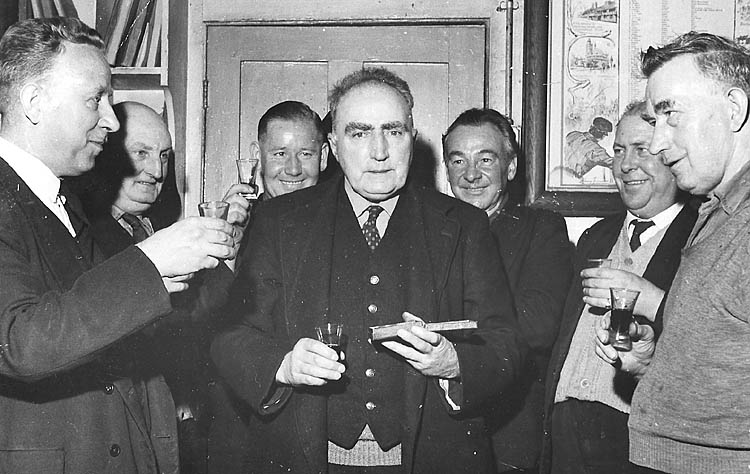|
Railways, Part III , Blisworth, Northamptonshire, UK. All pictures are presented at relatively low resolution. Printed below each image is the photographer's name, if known. |
|
|
Back to INDEX page Part I Part II This is Part III Part IV |
|
|
27-30 An artwork from 1837 shows the construction of the railway bridge over the canal. The lattice of cast-iron beams can be seen. |
|
|
27-31 This picture taken around 1900 shows the bridge and the gas house. The chimney "behind" the gas house was actually built onto the rear corner of the building and served the steam engine that was used to pump water up from reservoirs next to the canal. The other chimney is believed to be for the workshops which accommodated blacksmiths who maintained railway wagons - it is mentioned on the previous page. Next to the bridge can be seen a modest house - no one knows what it was for.. On an early map it carries the label P.L. It was Bert Varney who supplied the answer in one of his letters to GF (box 26, 2002) - the large hut was for railway workmen - Plate Layers. He also supplied a drawing from memory of the old chimney - inset. |
|
|
27-37 A similar view but dated more recently at c 1930. The houses on the far left were a pair of railway cottages - one was the stationmaster's house. At first, the stationmaster was accommodated in one of the two villas at the Northampton Road end of Station Road. The various sheds in the field were agricultural. The bungalow was used to house Belgian refugees in the late 1930s. It was built by the Griffith family in 1927/8 and demolished in about 1984 by Peter Griffith who then built the bungalow that now stands there (early 2000s). On the skyline above the bungalow is the railway goods-shed.
|
|
|
27-36 The stationmaster with his dog. Name and date unknown. See the listings for ideas circa 1900 judging from the dress. |
|
| 27-32 A gang of men at
Blisworth Station. The man with the horse is the mail messenger
who would take Northampton and Towcester mail to/from the sorting shed
in Blisworth High Street.
Apart from the evidence that the men are very confident about train punctuality, the picture is puzzling because there appear to be no wooden sleepers under the rails. |
|
| 27-33 A gang of smartly turned
out railway workers - date and location are not known though it seems to
bear a resemblance to the Richard Thomas (of former RTB) gated
sidings for the transshipment of ironstone onto the SMJ rail line.
If true, the date would have been circa 1942. This suggestion was
made by SMJ member Gary Loveday.
The camera should have Blisworth station behind and be looking up a gentle grade. In the distance the high bank for the Gayton to Blisworth road should be visible (the rail line cuts through the bank) but, and it's a big but, the mistiness on the day obscures that. Let's see if there are other suggestions . . . |
|
| 27-29 This picture and the next were taken in 1961 at the time of the change to the bridge where the cast-iron was encased in concrete, prior to electrification of the line. | |
| 27-28 | |
| 27-34 This picture and the next were taken in the mid-1960s as the station was dismantled. Here the gas house meets its demise. The picture is interesting in showing the large water reservoir (now partially filled in) fed from the canal. | |
| 27-35 The last images of fine cast iron work which once supported the platform canopies. | |
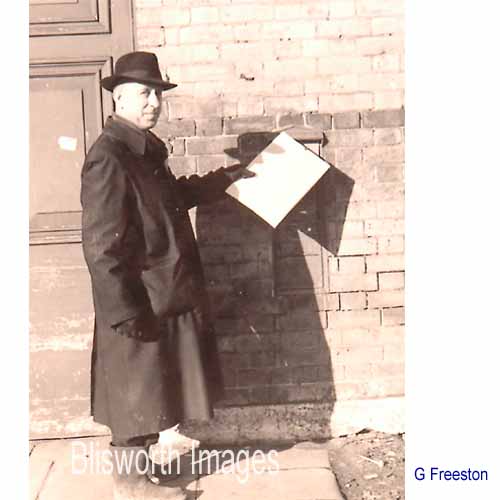 |
27-39 Last post from the station letter box today. Jack Almond, last stationmaster, posts the last letter.
|
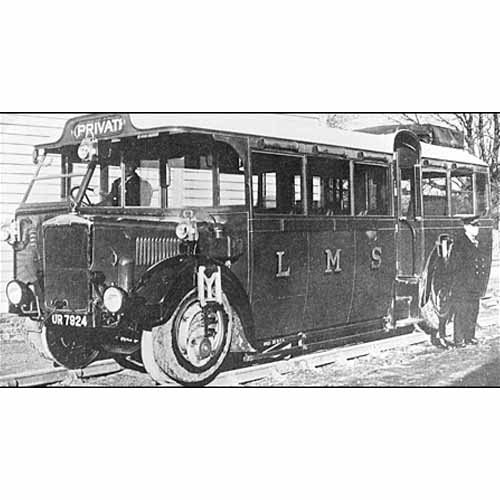 |
27-38 The "Ro-Railer" Designed by J. Shearman, who worked for the LMS railway, this vehicle was a hybrid single decker bus, built by Karrier Motors of Huddersfield with a Craven body, equipped with both tyres and flanged steel wheels. It was put into use in early 1932 and worked on the rails between Blisworth and Stratford Goods Yard on the SMJ line. The different pairs of wheels were exchanged using levers that were stored inside. The levers were used at each axle in a manner presently available on line* From the goods yard it made its way through the streets of Stratford to the Welcome Hotel. The service was discontinued after only a few months.
* see http://www.warwickshirerailways |
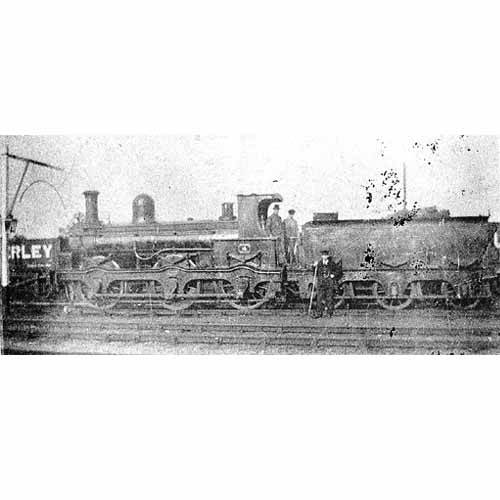 |
27-39 Dated approx 1908, this is SMJ No4. |
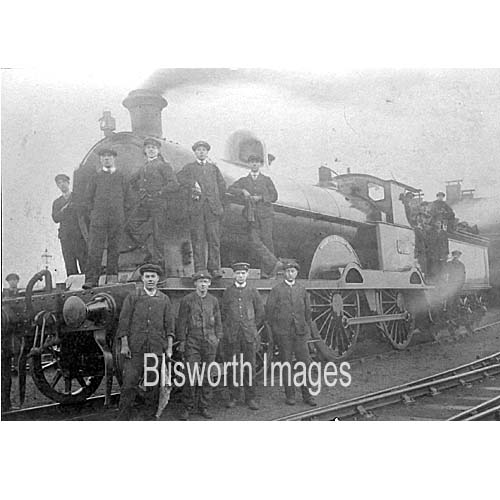 |
27-39a Dated probably around 1914, this fine
picture shows a "Precursor" which were top link L.N.W.R. engines for
their day but not the most powerful. They were eclipsed
in performance by G.W.R. and early L.M.S. and L.N.E.R. machines so that
double heading was very common on L.N.W.R. expresses. This is most
likely to be at the Northampton depot where they would have been routinely
serviced.
L.N.W.R. men displayed a fierce loyalty to their railway as can
be detected in the group proudly posing around the loco - the group
including most grades of maintenance and footplate staff. |
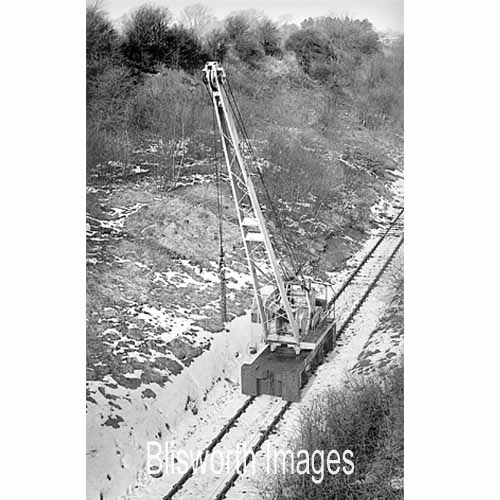 |
27-40 This picture is said to show the SMJ line being
taken up, probably in a January. It was probably taken at the bridge
for the road to the Gayton Wilds.
Removal of rails took hold from 1961 onwards yet RTH were still using the northerly 1/4 mile section of the SMJ line in order to continue delivery, until 1967, of ironstone at the long parallel sidings just a few 100 yards north of where this picture was taken. The gauges of the mineral railways and the national railways was the same. Once the SMJ line was non-existent to the south, engineers lifted some track near the sidings and made a more or less permanent link with BR. This was illegal but it saved time messing about at the sidings. I suppose there was the risk of a runaway train of wagons hurtling into the closed Blisworth Station, demolishing the SMJ buffers and coming to a stop in front of the hotel. (see Tonks) |
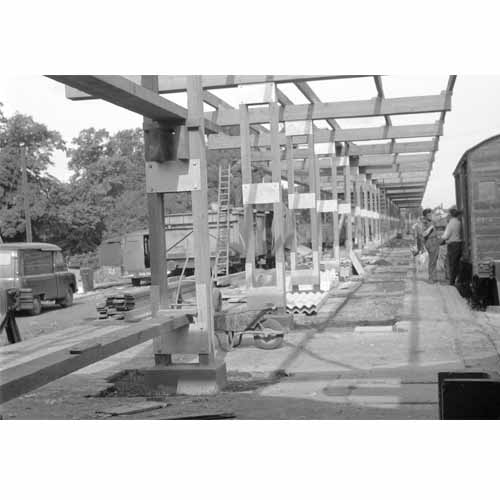 |
27-41 The SMJ platform at Blisworth Station was actually refurbished at the time that Euston Station was being rebuilt - long after Blisworth Station had been closed for passengers and stripped. The objective was to handle parcels at this location - date c. 1965. |
| This was taken in the station
master's office, circa 1965, on Jack Morrisroe's completion of either 40
or 50 years service on the
railway. From left to right, Jack Almond (stationmaster), Tom Cleaver
(porter & lampman) of Stoke Bruerne, Eric Pickles (shunter) of Roade,
Jack Morrisroe (signalman) of railway houses on the old A43 Blisworth,
Jack Reeves (head shunter) of Gayton, "Nobby" Clarke
(permanent way inspector?), and Fred Mansfield (porter & number
taker) of Gayton. Other Blisworth people employed on the railway around
this time were - Bill Skeene (signalman), Neville Busby (signal
& telegraph), George Clarke (signal engineer) and a group of
ladies with the rank of porter serving as Royal Mail parcel sorters* for
the 4 to 5 years while Euston
Station, where parcels were usually sorted, was being remodelled.
There was Nell Blood, Joan
Brown, Ruby Whitlock, Maureen Williams,
Sheila Mavis and Diane Curtis. Information courtesy of John Almond, photo: Chronicle & Echo ? * we learn from one of them, who shall be anonymous, they sometimes had a great time. Memorable were the unlocked crates of theatrical costumes which tempted two of them to don a stage donkey with flashing eyes, but alas no batteries, and prance up and down the main platform as the drivers of the through expresses took their double-take. Mainly it was heavy work, there being practically no limit to the weight of a parcel consigned by railway - rolls of lino, gas cylinders and motor parts were pretty much the norm. John Whitehead also has memories of various characters who worked on the railways. |
|
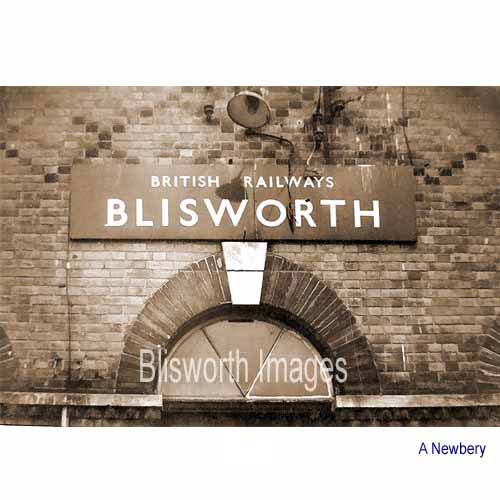 |
|
